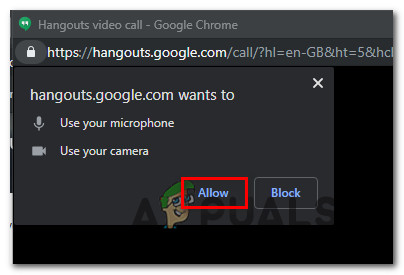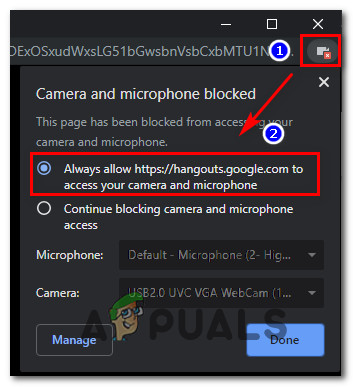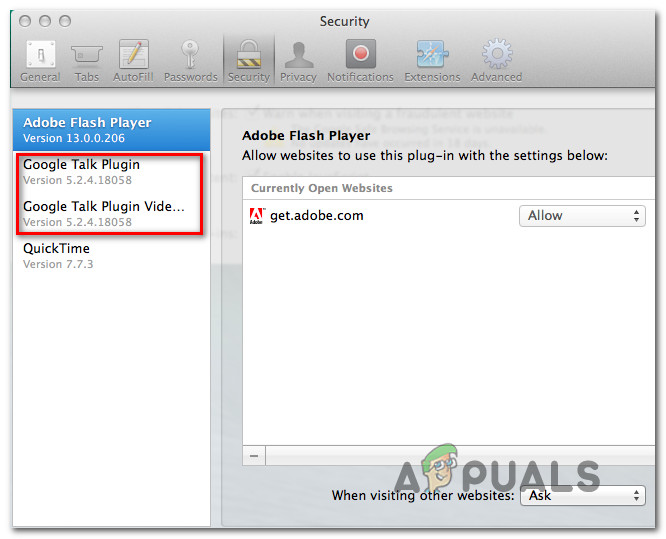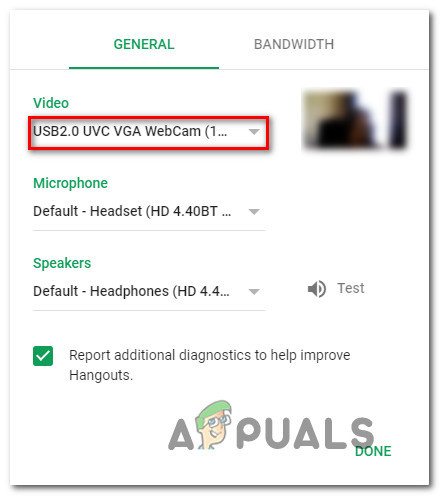How to Fix Google Hangouts Camera not Working
Several Windows users are reporting that they are unable to use their integrated or external camera with Google Hangouts. Affected users are reporting that the camera works just fine with other applications (built-in and 3rd party). The issue does not seem to be exclusive to a certain Windows version or a browser since it’s confirmed to occur on Windows 7 and Windows 10, as well as a wide range of browsers including Chrome, Firefox and Microsoft Edge.

What is causing Google Hangouts camera issues?
We investigated this particular issue by looking at various user reports and the repair strategies that are commonly being used to fix this particular problem. As it turns out, there are several culprits that are known to trigger this problem:
- Google Hangouts is not allowed to use your camera – In most cases, this particular issue occurs because the Hangouts web application doesn’t have the necessary permissions to use the camera. If this scenario is applicable, you can resolve the issue by accepting the permission prompt related to the webcam or allowing it from the settings screen.
- Chrome built is outdated – The issue can also occur due to a minor Google Chrome glitch that has been since patched. Instead of opening a communication window, outdated Chrome browser will redirect the users to a static page saying that the camera is not detected. In this case, you can resolve the issue by updating your Chrome version to the latest.
- Hangouts has a different camera set as the default – This is highly counter-intuitive and ends up confusing a lot of users. Instead of sticking with the default camera, Hangouts sometimes pick a different camera when opening a new communication window, which ends up triggering this issue. If this scenario is applicable, you can resolve the issue by changing a Hangouts settings.
If you’re looking for a fix that will resolve this issue, this article will provide you with several troubleshooting steps. Down below, you’ll find a collection of verified methods that other users in a similar situation have successfully used to resolve the issue.
All potential fixes featured below are confirmed to be working by at least one user that was affected by this problem. For the best results, we advise you to follow the methods in the order that they are presented since they are ordered by efficiency and severity. One of them is bound to resolve the issue regardless of the culprit that’s causing it.
Method 1: Allowing Hangouts to use your camera
Regardless of the browser or the operating system that you’re using, keep in mind that Hangouts needs your permission in order to use your camera. Maybe you missed the popup or maybe you mistakenly clicked on Block when the pop-up initially appeared.
This is by far the most common issue that will trigger this problem based on user reports and the vast majority of users. Since the fix is a little different depending on which browser you’re using, we broke this guide down into two separate guides – one for Safari, and one for the rest of browsers that have very similar instructions (Chrome, Firefox, Opera).
Feel free to follow whichever guide is appropriate to your current situation.
Chrome, Firefox, and Opera
So if you haven’t interacted with the Hangouts prompt until now, look for it in the top-left section of the screen (immediately after you try to open a video call with someone) and click on Allow.

If that prompt no longer appears, chances are you already interacted with the prompt and disabled it by default. In this case, you can allow camera access to Hangouts by clicking on the blocked-popup icon in the top-right corner of the screen.

After you click the pop-up icon, select the toggle associated with Always allow *URL* to access your camera and microphone. Then, make sure the right Camera is selected before clicking on the Done button.
Safari
On Safari, the steps of getting the Hangouts camera to work are a little different since you will need to begin by installing the Hangouts plugin. To do this, visit this link (here) and click on Download Plugin.
If you already have some version of the Hangouts plugin, you will be prompted to update via the Update Plugin button. Then, follow the on-screen prompts to complete the installation and install the plugin.

Once the plugin has been installed, click on Video call to initiate a call, then click on Trust to grant Hangouts access to your camera. If you don’t see the option to trust the Hangouts web app, chances are you’ve canceled this option before. In this case, you need to go to Safari > Preferences > Security and then click/tap on Plug-in Settings.
Then, scroll through the list of plugins and find the Hangouts plugin. Once you see it, set the toggles associated with Google Talk Plugin and Google Talk Plugin Video Renderer to On (or Allow).

Click Done, then attempt to reconnect by reloading the page. You should now be able to use the camera without issues.
If your camera still doesn’t work on Hangouts, move down to the next method below.
Method 2: Updating drivers to the latest (Chrome only)
If you’re having Hangouts camera issues exclusively with Chrome, chances are you are affected by a Chrome-specific issue that has been around for a couple of years now. Affected users have reported that trying to open a video conversation on Hangouts leads to a “No Camera Found” static page. Fortunately, the glitch has since been patched, so you should be able to resolve the issue just by updating your browser client to the latest version.
Here’s a quick guide on how to do this:
- Open Google Chrome and click on on the action button in the top-right corner of the screen.
- Then, click on Help > About Google Chrome from the newly appeared menu.

- Once you’re inside the About Chrome tab, click wait until the utility determines if you have the latest version. If you don’t click on Update Google Chrome to update to the latest build.

Update Google Chrome - Once the updating process is complete, restart your computer and see if the issue is resolved.
If the issue is still not resolved, move down to the next method below.
Method 3: Setting the right Camera from Hangouts settings
If you’re having an integrated webcam but you’re trying to use an external webcam with Hangouts (or vice versa) chances are the Hangouts app is not configured to use the same device that you’re targeting. This can be rectified easily by adjusting some Settings from within the app.
Several affected users have reported that they managed to resolve the issue after accessing the Settings menu of Google Hangouts and making the switch to the correct camera. Here’s a quick guide:
- Initial a call window normally by clicking on Video Call.
- From the video call window, click on the Settings icon on the top-right section of the screen.
- Next, go to the general tab and change the item under the Video to your active camera using the drop-down menu.

Changing the camera settings on Google Hangouts - Click Done to save the change, then reload the Google Hangouts Page and see if the issue is now resolved.
Workaround(MAC):
- Quit out of chrome completely by pressing “cmd” + “Q” on your MacBook.
- Launch the Facetime application.
- Open Chrome and then start Google Hangouts.
- Check to see if the issue persists.




